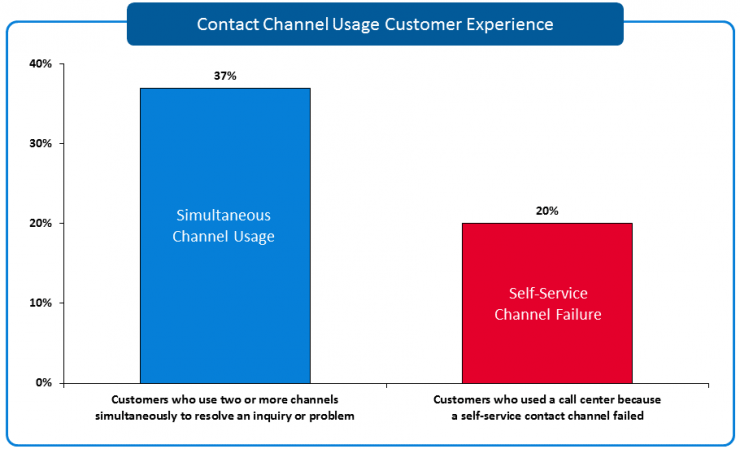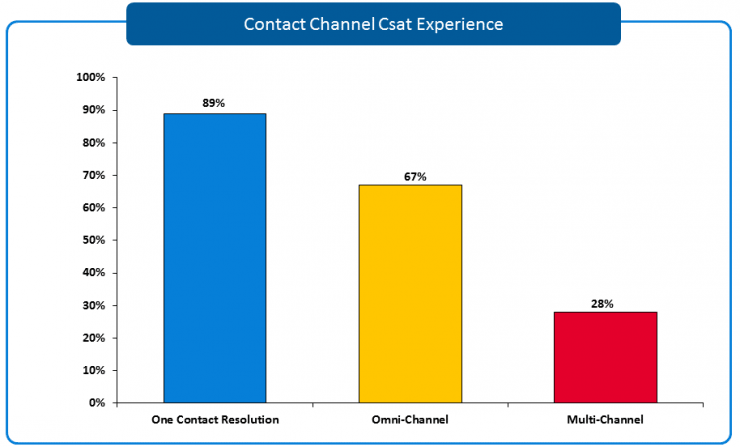
Customer Contact Channel Usage
SQM is proud to share some of our Customer Contact Channel Usage and Experience Research with you. Our research data reveals that 20% of customers used a call center because a self-service contact channel failed.
Furthermore, our research data also revealed that 37% of customers simultaneously use two or more contact channels to resolve an inquiry or problem. For example, a customer used the web channel while at the same time talking to a call center Agent.
Many SQM clients consider customers using two channels simultaneously to resolve an inquiry or problem as a ‘channel assistance practice.’ Interestingly, when customers use two channels concurrently to resolve an inquiry or problem, 62% of the time, it is the web and call center channels, which is by far the most popular combination of channels being used.
With ‘simultaneous channel usage,’ most customers do not expect one of the channels to resolve their inquiry or problem. Put differently, customers just used one of the channels as an aid for resolving their inquiry or problem. So, when the simultaneous combination is web and call center channels, the web channel is the aiding channel for resolving their inquiry or problem. The call center is the channel customers expect to be able to resolve their inquiry or problem.

Given that at least 20% of call center customers use two or more contact channels to resolve the same inquiry or problem because of a self-service channel failure. Moreover, 37% of customers use two or more channels simultaneously to resolve an inquiry or problem; it should be considered essential to understanding the customer’s entire contact channels experience if an organization wants to improve Csat.
Of the organizations SQM works with organizations trying to improve the experience for customers who use two or more contact channels to resolve the same inquiry or problem, and many are using an omni-channel strategy. At its core, an omni-channel practice is an integrated customer service approach that provides the customer with a seamless experience to resolve their inquiry or problem. For example, a customer can be shopping online and then decides to phone the call center.
With an omni-channel practice, the Agent sees all of the customer’s online information resulting in the customer not having to start their transaction from the beginning; therefore, making it a seamless experience. However, the industry has much confusion on identifying the differences between multi-channel and omni-channel from a customer experience point of view. Essentially, it comes down to the depth of the integration of people, processes, and technology within the contact center. To help clarify customer experience differences between the contact channel operating practices, SQM has developed the following definitions:
- Omni-channel – Defined as a customer who had a seamless experience across all contact channels to resolve the same inquiry or problem. Put differently, when a customer used another contact channel to resolve the same inquiry or problem, they were able to pick up from where they left off in the previous contact channel and, as a result, did not have to start from the beginning.
- Multi-channel – Defined as a customer who did not have a seamless experience when using multiple channels to resolve the same inquiry or problem. In other words, the customer had to start their interaction from the beginning each time they used another contact channel to resolve the same inquiry or problem.
- One contact resolution – Defined as a customer who resolved their inquiry or problem in one contact using only one channel.
SQM’s experience shows that few organizations know their customers’ satisfaction (Csat) when using specific contact channels (e.g., IVR self-service, mobile self-service, email, and chat. Moreover, they also do not Csat when using multiple contact channels to resolve the same inquiry or problem.
As a result, SQM is often asked, “What are the differences between one contact resolution, multi-channel and omni-channel customer experience from a customer satisfaction (Csat) point of view?” The below figure shows Csat (top box response) based on the contact channel customer experience for resolving a customer’s inquiry or problem.
The main finding is that the easier it is for a customer to resolve their inquiry or problem, the higher the Csat. That is why the One Contact Resolution customer experience has the highest Csat (89%) by far of all the contact channel customer experiences and is at the world class level for Csat.
SQM considers 85% or higher Csat (top box response) to be at the world class Csat level for contact channel experience for resolving an inquiry or problem. However, only 5% of SQM’s clients can achieve that level of contact channel Csat experience performance for resolving an inquiry or problem.
For customers who use two or more channels to resolve the same inquiry, Csat is 39% higher when it is an omni-channel seamless experience than when it is a multi-channel non-seamless experience.
Omni-channel Csat is 67%, and multi-channel Csat is 28%, which is by far the lowest of all the contact channel customer experiences. In addition, Omni-channel Csat for resolving an inquiry or problem is at the 3rd quartile contact channel customer experience performance level, which needs improvement. SQM research shows that providing One Contact Resolution is the best opportunity to provide world class Csat and retain customers.

Quick Related Links
First Call Resolution Definition First Call Resolution PPT First Call Resolution Benefits
First Call Resolution Strategies First Call Resolution Operating Philosophy First Call Resolution Formula What is a Good FCR Rate? One Contact Resolution Channel Hopping Top 10 Contact Channel CX Metrics
